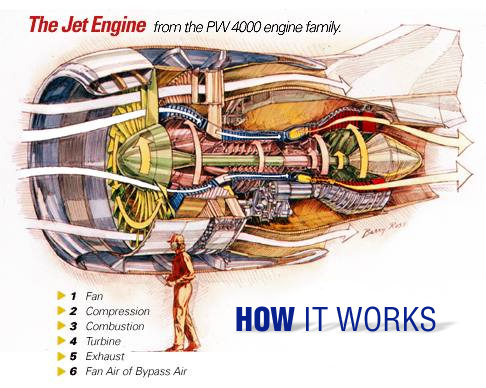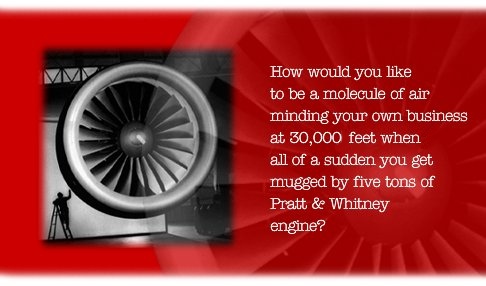|
Over the course of the next 40 thousandths of a second
you, Mr. or Ms. Molecule, will be beaten through 18 stages of
compression, singed in a furnace heated to nearly 3,000 degrees
Fahrenheit, expanded through a turbine and pushed out the back with
a wicked headache and the bitter knowledge as the aircraft screams
on that your ugly ordeal has been merely for the sake of getting
Aunt Mildred to Phoenix for a much needed rest.
That’s
basically what happens every day in the skies above as thousands of
Pratt engines power aircraft from place to place while the
passengers and crew inside those aircraft experience only the steady
and reassuring thrum that results from Pratt’s precision
manufacturing.
The principle
of jet propulsion has been demonstrated by anyone who has blown up a
balloon for a child and accidentally let go before tying it closed.
The air stored up inside the balloon accelerates as it rushes to
escape through the narrowest part of the balloon’s neck. This
acceleration, or change in the speed of air, combines with the
weight of the air itself to produce thrust. It is the thrust that
sends the renegade balloon zipping madly about the room.
The original
turbojet engine, which debuted in scheduled commercial service in
1952, accomplished this same trick on a breathtaking scale and with
pinpoint control. The progress of jet engine technology in the past
four decades has been to increase the amount of air going into the
engine, and change the speed of that air with ever greater
efficiency. All the examples in the article are drawn from the
mightiest family of engines ever to fly, the Pratt & Whitney
4000s. | |
 |
| 1. Fan |
The propulsion process
begins with the huge, 9-foot-diameter fan at the front of the
engine, spinning 2,800 times a minute at takeoff speed. That fan
sucks in air at the rate of 2,600 pounds per second, or enough to
vacuum out the air from a 4-bedroom house in less than half a
second. |
| 2. Compression |
As
the air leaves the fan it is now separated into two streams. The
smaller stream, about 15 percent of the total volume of air, is
called primary or core air and enters the first of two compressors
that are spinning in the same direction as the fan itself. As the
primary air passes through each stage of the two compressors, both
its temperature and pressure rise. |
| 3.
Combustion |
When compression is
complete, the air, now 30 times higher in pressure and 1,100 degrees
hotter, is forced through a furnace or combustor. In the combustion
chamber, fuel is added and burnt. The air’s temperature soars even
higher, and the air is finally ready to do the two jobs for which it
has been so hastily prepared. |
| 4. Turbine |
The first job is to blast through the blades of two
turbines, sending them whirling just like the wind spinning the arms
of a windmill. The whirling turbines turn the shafts that drive both
compressors and the fan at the front of the engine. This process, in
which the engine extracts energy from the air it has just captured,
is what allows modern jets to operate with such high fuel
efficiency. |
| 5. Exhaust |
The second job is to
push the airplane. After passing through the turbines, the hot air
is forced through the exhaust opening at the back of the engine. The
narrowing walls of the exhaust force the air to accelerate and, just
as with the balloon, the weight of the air combined with its
acceleration drives the engine, and the airplane attached to it,
forward. |
6. Fan Air or
Bypass Air |
The larger air
stream exiting the fan, representing 85 percent of the total, is
called fan air or bypass air, because it bypasses this entire
process.
The engine
itself is shrouded in a metal casing called the nacelle, shaped
roughly like a sideways ice cream cone with the bottom cut off.
Bypass air is forced through the ever narrower space between the
nacelle wall and the engine, picking up speed along the way.
Because of its
huge volume, bypass air needs only to accelerate a small amount to
produce an enormous kick of thrust. In the PW4084 engine, bypass air
accounts for 90 percent of the thrust, and has the added benefits of
keeping the engine cooler, quieter and more fuel efficient.
| |







